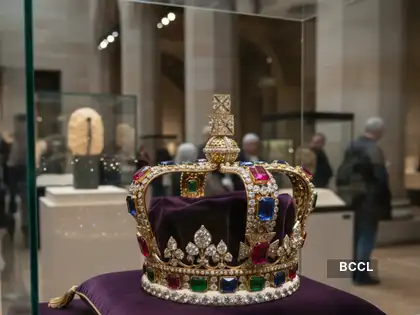the morning the louvre went dark
Paris woke to the sound of sirens spiraling across the Seine. On a crisp Sunday morning, 19 October 2025, the Louvre Museum — the world’s most visited temple of art — was violated in one of the most audacious cultural crimes of the century. Within minutes, thieves had breached the Apollo Gallery and disappeared with a selection of France’s crown jewels, leaving smashed vitrines, a broken crown, and a shaken nation.
For a museum synonymous with mastery — home to the Mona Lisa, the Venus de Milo, and centuries of European brilliance — the theft felt like an act of defilement. The Louvre had been robbed before, yes, but never like this: a surgical strike in broad daylight, executed with mechanical precision and theatrical flair, echoing both a Hollywood script and the ghosts of imperial France.
daylight at the apollo
The Apollo Gallery is not just a hall. It is an ornamented corridor of France’s soul — a gilded nave celebrating light, triumph, and divine craftsmanship. Built under Louis XIV and restored by Napoleon III, it houses the crown jewels of France, including treasures from Marie-Amélie, Marie-Louise, and Empress Eugénie.
Around 9:30 a.m., just as the museum began to fill with visitors, a maintenance vehicle — later identified as a rented cherry picker — rolled quietly onto the riverside. Two men in reflective vests ascended toward a second-floor window. Security guards, accustomed to contractors, took little notice. Within seconds, an angle cutter sliced through the casement lock. The intruders slipped inside, masked, and armed with hammers.
They knew exactly where to go. Glass shattered, alarms faltered, and in less than seven minutes, centuries of monarchy were plucked from their pedestals. When the thieves sped away on motorbikes, trailing shards of glass across the Pont du Carrousel, Paris had lost more than jewels — it had lost an emblem of its continuity.
what was taken
Initial reports varied. The French Ministry of Culture confirmed the theft of eight to nine pieces, all from the historical imperial collection. Among them:
– A sapphire tiara and necklace once belonging to Queen Marie-Amélie and Queen Hortense, daughters of the Bonaparte line.
– An emerald parure given by Napoleon I to his second wife, Marie-Louise, in 1810 — its stones said to embody fidelity and rebirth.
– A diamond bow brooch and tiara of Empress Eugénie, wife of Napoleon III, both 19th-century triumphs of French haute joaillerie.
– And, most heartbreakingly, the Crown of Empress Eugénie, discovered hours later discarded in the Tuileries gardens — its frame twisted, gems torn free.
The missing jewels were not simply precious; they were symbolic. Each carried stories of empire, exile, and restoration. Marie-Louise’s emeralds were gifts of reconciliation after divorce from Joséphine. Eugénie’s tiaras were emblems of modern femininity and empire-era glamour. Their loss reverberated far beyond monetary value; they represented the public ownership of history itself.
a perfect storm of fragility
The Louvre’s director called it “an attack on France’s heritage.” Yet insiders say the warning signs were visible long before.
The museum has battled years of staffing shortages, union disputes, and surging visitor numbers — 9 million in 2024 alone. In June 2025, workers staged a walkout over “untenable crowding and insufficient security coverage.” The Apollo Gallery, ironically one of the museum’s most ornamented yet vulnerable spaces, required specialized oversight due to fragile plasterwork and window restoration. That maintenance opened opportunities.
The thieves exploited exactly that: external scaffolding, reduced guard rotation, and the illusion of routine construction. They operated at a time when cameras and staff were spread thin across multiple entrances. A cherry picker with a falsified work order became their passport. The operation was both low-tech and masterful — a reminder that the world’s greatest museum still rests in a very old palace.
how to steal history
Art theft, at its core, is an act of audacity — but jewel theft adds another layer: destruction as disguise. Unlike paintings, which must remain visible to retain value, jewels can be melted, recut, or reset. As jeweler Tobias Kormind told PBS, “These stones will vanish — they’ll be recut, their provenance erased.”
The French Crown Jewels were disassembled once before — in 1887, when the Third Republic sold most of them to abolish royal symbolism. What remains today are fragments of a vanished monarchy. That the surviving pieces were taken now, in an age of digital surveillance and museum guards in earpieces, feels both ironic and tragic.
Interpol was notified within hours. Customs checks were ordered at airports, ports, and jewel exchanges. But experts agree that the thieves likely split the gems almost immediately, handing them to parallel fences or gem-cutting ateliers in Belgium, Switzerland, or the Gulf. Once recut, a royal emerald becomes just another green stone.
the echo of empire
To understand the emotional shock, one must appreciate what these jewels mean to France. They are the tangible residue of its oscillation between monarchy and republic — symbols alternately celebrated and suppressed.
The Crown of Empress Eugénie, for instance, crafted in 1855, embodies the last glitter of the Second Empire before its collapse in 1870. Its design — 1,354 diamonds and 56 emeralds — was a hymn to both empire and excess. That crown survived wars, exiles, and revolutions. That it did not survive the peace of 2025 feels almost poetic in its cruelty.
Cultural historian Élodie Marot described the theft as “the loss of a mirror.” “France sees itself through its objects,” she wrote. “To steal them is to steal a piece of our reflection.”
The Louvre’s gilded gallery — painted ceilings by Delacroix, crystal cases gleaming under chandeliers — once celebrated eternal light. Now, the irony is bitter: the Gallery of Apollo, god of the sun, has been dimmed.
the art world reacts
Global museums have rallied in solidarity. The British Museum and the Prado both issued statements reaffirming the need for shared heritage protection, while jewelry historians called for renewed international tracing efforts similar to the one launched after Dresden’s Green Vault heist in 2019.
Insurance experts estimate the financial loss in the tens of millions — though precise valuation is impossible, since many items were declared “non-insurable national property.” What cannot be insured, of course, is meaning.
Critics point out that cultural institutions, pressed for attendance and social-media visibility, now walk a dangerous line between openness and vulnerability. The Louvre’s accessibility — once its greatest democratic virtue — became its flaw.
thefts across the art world
The Louvre’s loss is part of a troubling pattern. Earlier this month, a Pablo Picasso painting vanished during transport between two European galleries. In Egypt, a 4,000-year-old limestone relief disappeared from a provincial museum; weeks later, officials discovered a melted-down gold bracelet that had sold for less than $4,000.
The message is clear: cultural artifacts remain lucrative prey. In the global black market, where national treasures become private trophies, history itself becomes negotiable.
the race to recover
French investigators are treating the theft as organized crime. Security footage is being parsed frame by frame, though insiders admit some cameras in the gallery were undergoing maintenance. Forensic teams found traces of metallic dust and rubber boot marks near the window. A partial serial number on the lift may yet lead to arrests.
Interpol’s Art Crime Unit has circulated images to jewel exchanges and luxury-goods dealers worldwide. Yet experts give recovery odds below 10%. Once a gem is recut, even microscopic isotopic analysis cannot always prove origin.
The Louvre remains open — but the Apollo Gallery is closed “until further notice.” Its empty vitrines, covered in black velvet, have become a spontaneous memorial. Visitors leave flowers, notes, and postcards addressed simply À Eugénie.
france in reflection
France has always balanced grandeur with fragility. Its monuments stand not merely as architecture but as psychological symbols — proof of endurance. When they are damaged, the wound feels personal.
Minister of Culture Bérangère Couillard called the robbery “a national humiliation.” Newspapers used darker metaphors: the daylight desecration, the new Mona Lisa moment. Indeed, the 1911 theft of da Vinci’s masterpiece transformed the Mona Lisa from a Renaissance curiosity into a global icon. The 2025 heist may have the same paradoxical effect: absence creating fame.
But the question remains — at what cost?
the museum’s crossroads
The Louvre stands at a difficult intersection of the 21st century: mass tourism, digital culture, and the economics of spectacle. While its revenue depends on accessibility, its essence depends on protection.
Following the theft, the museum announced a €40 million upgrade to its security infrastructure — thermal sensors, reinforced glass, AI-assisted surveillance. Yet the deeper issue is philosophical: Can a museum built on the ideal of public trust remain both open and secure?
Museologist Claire Dupont believes the answer lies in humility. “We have treated museums like theme parks,” she said. “This reminds us they are sanctuaries.”
impression
In mythology, Apollo was the god of music, prophecy, and the sun — but also of healing. Perhaps it is fitting that the Louvre’s wounded gallery bears his name.
The loss of the crown jewels is devastating, yet it may spark renewal: a reevaluation of how we protect, interpret, and value cultural property. The jewels may be gone, but their stories — of empire, artistry, and resilience — remain intact.
At dusk, as the Louvre’s glass pyramid catches the evening light, the reflection still dazzles. The sun sets, the city endures, and the ghosts of emperors glitter unseen.
No comments yet.








